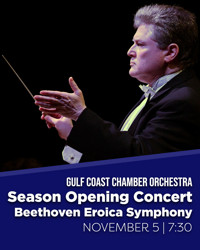A new season begins! The Gulf Coast Chamber Orchestra performs one of Beethoven’s most celebrated works, the Eroica Symphony.
Program:
- Rossini – Overture to The Barber of Seville - The original Overture for The Barber of Seville was mysteriously lost after its premiere in 1816. However, Rossini, armed with a chest of musical delights not yet used, recycled some of his old opera themes and created what we now know today as the Overture to The Barber of Seville. Therefore, similarly to that of Mozart’s The Marriage of Figaro Overture, Rossini’s new opener bears absolutely no musical resemblance to that of any of the opera’s music. This can sometimes prove a hard sell for the composer when the music didn’t represent the product, however the quirky Overture became one of his staple works, with it often being heard as a stand-alone concert piece.
- Haydn – Symphony No. 100 - The most popular of all the twelve London symphonies was the one in G major, which received its premiere performance on March 31, 1794. (It is now known as Haydn’s Symphony # 100 according to the compendium compiled by Eusebius Mandyczewski in 1907 which was remarkably complete, omitting only two youthful works, even though the chronology of the earlier works has been corrected by subsequent scholarship.) By tracing watermarks on the pages of the autograph score, Landon found that Haydn wrote the third of its four movements, a menuetto, in Vienna between his two London trips. The extraordinary second movement is an arrangement and elaboration of a concerto for two lira organizata (a sort of hurdy-gurdy) that Haydn had written in 1786 for the King of Naples. Haydn presumably wrote the outside movements between his second arrival in London on February 4 and the premiere.
- Beethoven – Symphony No. 3 (Sinfonia Eroica, Heroic Symphony ) is a symphony in four movements by Ludwig van Beethoven. One of Beethoven’s most celebrated works, the Eroica symphony is a large-scale composition that marked the beginning of the composer’s innovative “middle period”.
SUBMIT UPDATES
Videos

|
Man of La Mancha
The Naples Players (3/12 - 4/13)
PHOTOS
| |

|
WAITRESS
Broadway Palm (4/11 - 5/24) | |

|
Ken Ludwig's Lend me a Tenor
The Studio Players (3/28 - 4/13) | |

|
Shout! The Mod Musical
Florida Repertory Theatre (3/18 - 4/13) | |

|
Four Old Broads
Arts Center Theatre (4/2 - 4/13) | |

|
The Hallelujah Girls
The Naples Players (5/7 - 5/25) | |

|
Prodigal Son by John Patrick Shanley
The Studio Players (5/16 - 6/1) | |
| VIEW SHOWS ADD A SHOW | ||
Recommended For You



